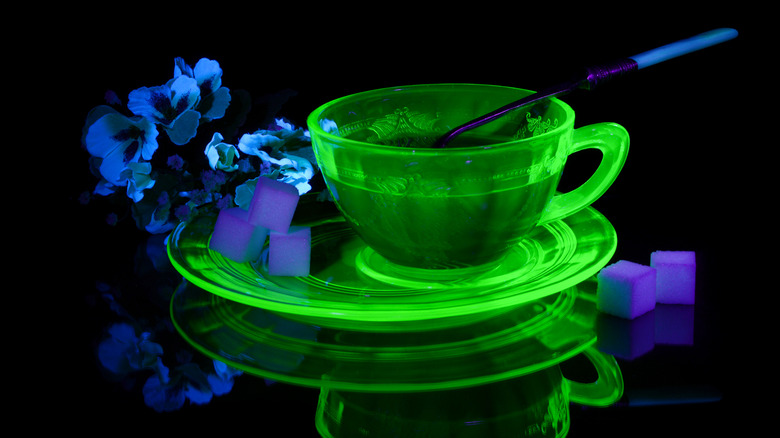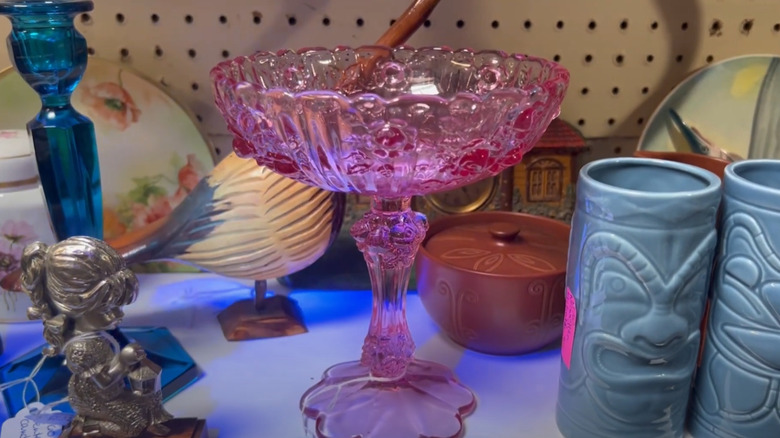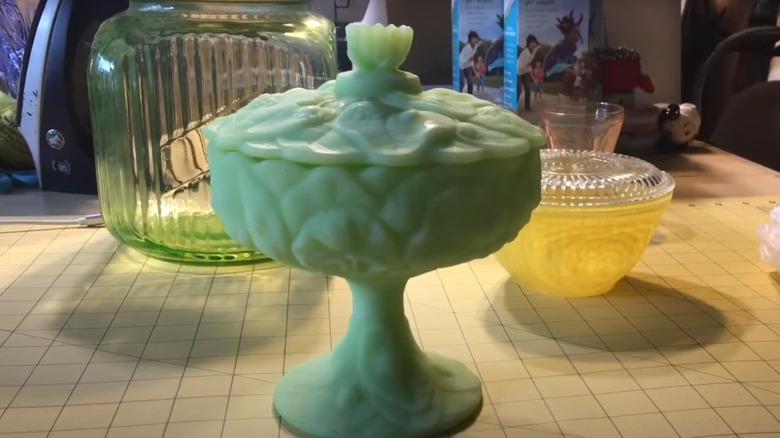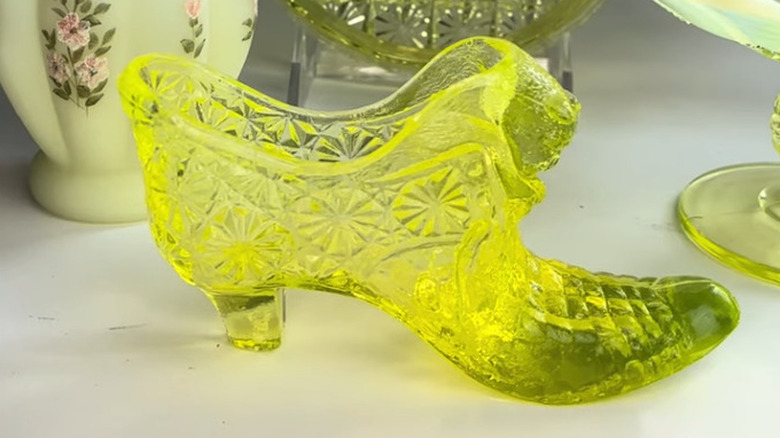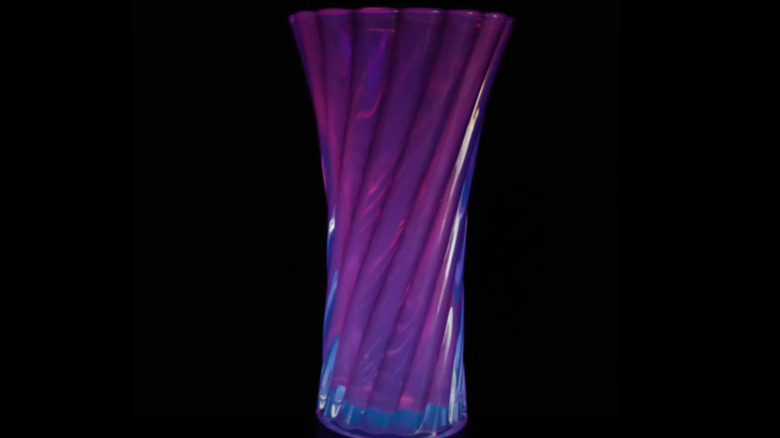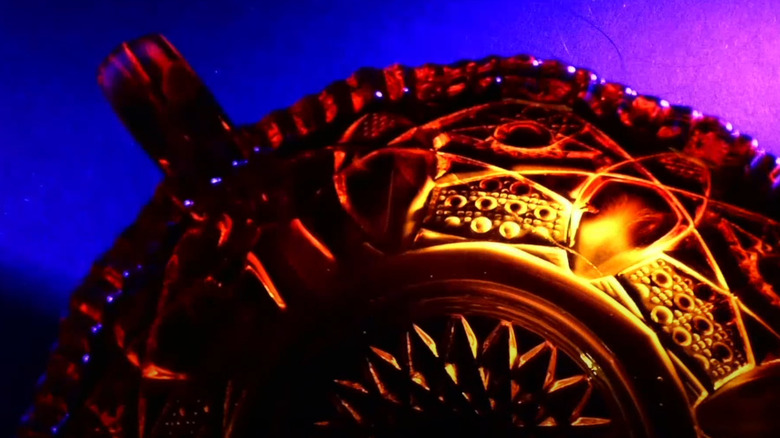6 Types Of Vintage Glass That Can Glow In The Dark
Few relics on thrift store shelves are as mysterious and intriguing as vintage glass that glows in the dark. They're pieces from centuries past that transform as the lights dim into a radiant display. The glasses' intricate designs are often eloquent as is in natural lighting, but under ultraviolet (UV) light, glowing glass illuminates, coming to life.
One of the most common types of vintage glowing glass is uranium glass, which first gained popularity in the mid 1800s. By incorporating radioactive, uranium compounds into the glass blowing process, European glassmakers discovered they could produce valuable, green-tinted pieces. But uranium isn't the only type of glowing glassware you can find at antique stores. There are more varieties of glow in the dark glass, some of which can turn pink, red, purple, or yellow under UV lights.
Luminous vintage glass can make for a beautiful and intriguing display, but there are understandable concerns surrounding the safety of keeping a glowing glass collection in your home. This is why experts suggest you should always check your vintage glassware for lead or any other substances that can be toxic or harmful. Not all types of glow in the dark glass are directly harmful, and some varieties are considered generally safe with proper handling. It's important to note however, that while vintage glass is beautiful, it's usually not be safe to drink from, so it should be used for display only. Here are six types of vintage glass that glows in the dark, and which types you might want to be wary of bringing home.
Selenium glass is rosy and rare
When thinking of glowing vintage glassware, it's easy to jump to uranium's neon green hues, but selenium glass paints a rosier picture. This glass variety was en vogue in the early 1900s when glassmakers included selenium compounds their technique to give glasses a pretty pink tint. Under ultraviolet rays, selenium glass can glow bold red and pink or omit a more delicate, pastel light. You can also find more intense ruby shades of selenium glass. Selenium is the perfect option for homes with more feminine or romantic decor, or in rooms with pink accents.
Custard glass is a timeless classic
Custard glass is a type of uranium glass with a more opaque, whitish tint. While there are many manufacturers of custard glass, the most famous was produced by Fenton Art Glass Company in the mid 1900s. Compared to other varieties of uranium glass that have more translucent glows, custard glass has a more understated, pale tint. Custard glass is often painted with intricate designs or delicate patterns, which only adds to the glasses' value and rarity. Custard glass can also contain lower amounts of uranium, which gives it a more subtle look.
Manganese glass is versatile and radiant
Manganese was another compound added by glassmakers to give their glassware a glowing effect. Manganese glass has a softer lilac tint and is a subtler alternative to bold uranium glass. Manganese was initially used as a de-colorizer in glassmaking, as glassmakers tried to achieve more clear glass pieces. However, sun exposure over the years can give manganese glass their signature purple tint. You can find a wide variety of jugs, plates, and dishes made of manganese glass, usually in an elegant amethyst shade. Under UV lights, they give off a muted green glow.
Vaseline glass is shimmering and intense
Vaseline glass is famous for its striking yellow and green hues when placed under ultraviolet rays. While custard glass is more opaque, vaseline glass gets its name from its coveted translucence and intense glowing effect. vaseline glass is also made with uranium, which gives it its bright radiance. Due to uranium's radioactive qualities, however, you do have to be careful of health hazards when thrift shopping for vaseline glass. Experts agree, however, that as long as you handle the glass with caution and don't eat or drink from it, it is widely considered safe.
Lead crystal glass can be beautiful but dangerous
Lead crystal is another type of glass that glows brilliantly under ultraviolet light, but it is also a variety you might want to be more cautious with. In centuries past, lead crystal was considered opulent and revered for its crystal-clear appearance, but modern science has revealed consuming from glass that contains lead can prove highly dangerous and poses risks of lead poisoning. By incorporating lead oxide, glassblowers achieved a shimmering blue glow under UV lights, making lead crystal a beautiful but more risky option when it comes to vintage glowing glass.
Cadmium glass is warm and lustrous
Finally, cadmium glass is famous for its warming red glow. In the late 1800s, glassmakers began to add cadmium sulfide compounds to achieve more of a range in their glasses' tints. The result was fiery red and orange hues that make a statement. Under UV lights, cadmium glass burns bright amber and crimson, making them popular with vintage glass collectors. Luckily, cadmium glass is considered one of the safer glass varieties for display, unless the glass is cracked or damaged which could potentially lead to contamination.
